
Get to know your sourdough yeast
As a part of the Sourdough citizen science project, we have sequenced the DNA of sourdough starters from around the world to better characterize sourdough microbial biodiversity. As we sift through data from that project, many participants want to know more about the yeasts identified in their starter. Here we provide profiles of research conducted on some of the most abundant sourdough yeasts.
In sourdough, yeasts are responsible for much of the leavening of dough as well as contributing to the flavor profile of bread. When we think of bread yeasts, many of us think of Saccharomyces cerevisiae – baker’s yeast. Perhaps not surprisingly, S. cerevisiae is a very common inhabitant of the sourdough starters we sampled. But we also found a wonderful variety of other lesser-known yeast species.
To help bread bakers better understand this yeast diversity, we’ve compiled information on lesser-known sourdough yeasts. Based on reports from the scientific literature, we provide highlights on where these yeasts live and what they can do in sourdough. We also provide photos of what these yeasts look like when they are isolated in the lab. This information is not meant to be comprehensive. For many yeasts, there is little known about what they do in sourdough. But we hope this page can serve as a quick guide to the natural history of sourdough yeasts.
One quick note on how to understand the photographs provided below. The photos on the left show colonies of yeast from a single sample of sourdough. The photos on the right show high magnification of individual cells taken from a microbial colony. A microbial colony is formed from millions of cells growing together in a Petri dish. The colony photos represent a single sample of sourdough, and so they contain multiple species (multiple types of colonies). You can generally tell these species apart by the way that they look (the size and overall appearance of colonies). See bottom of post for more details on the photos and other notes/caveats.
Kazachstania servazzii
Alternate names include: Saccharomyces servazzii
Some other environments where it has been found (based on DNA sequences in the National Center for Biotechnology Information): Body of the black soldier fly, Hermetia illucens, kimuchi- japanese fermented vegetables, kefir grain in Tunisia, soil in Finland.
What is it doing in my sourdough? Kazachstania servazzii is remarkable because it produces a lot of carbon dioxide gas (lots of dough rise), making it an excellent candidate for sourdough starters. It is also noted for its production of a number of volatile (smelly) compounds in certain fermented foods that may contribute to overall flavor profiles. However, the presence of K. servazzii is also a concern for many commercial food producers as all that gas can cause swelling and even bursting in packaged foods, including in packaged raw pizza dough (Spanoghe et al. 2017).
Kazachstania unispora
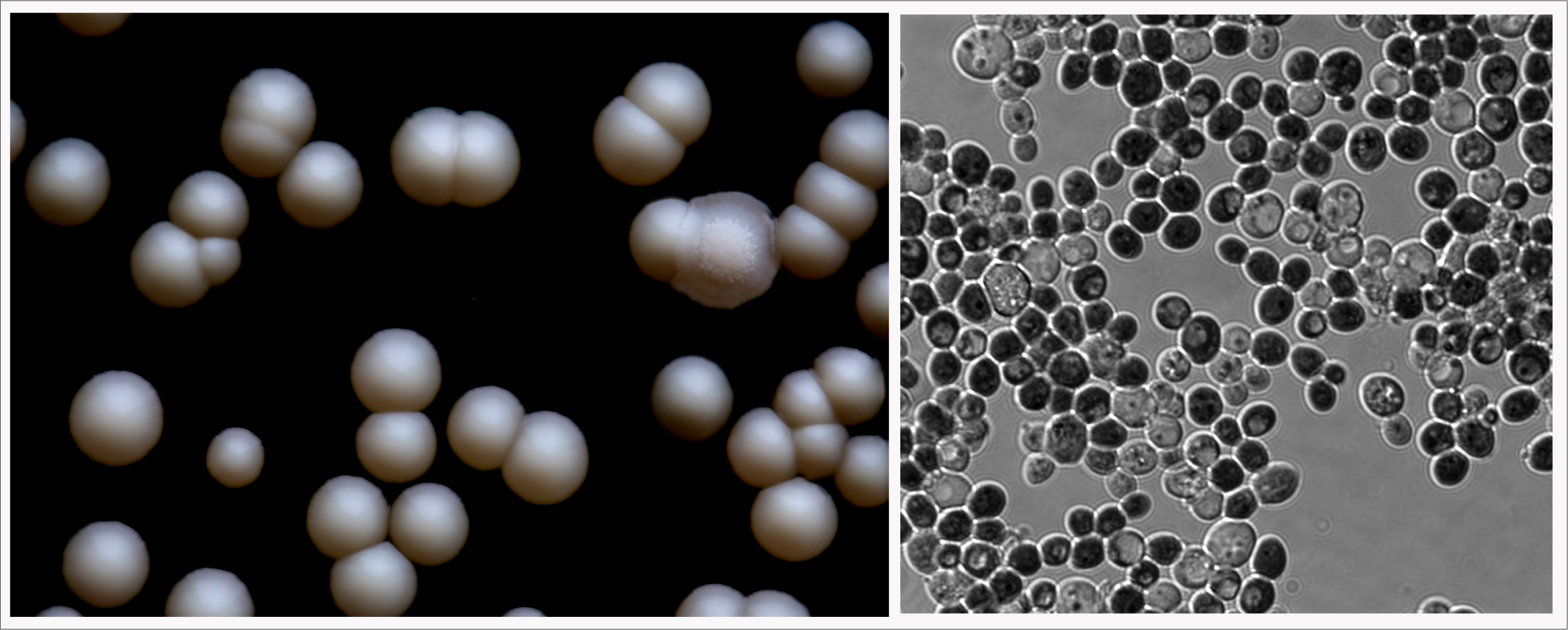
Left: K. unispora are the smooth, round colonies. The colony with the fuzzy center is Wickerhamomyces anomalus. Right: K. unispora cells at magnification.
Alternate names include: Saccharomyces unisporus
Other environments where it has been found: yogurt in Poland, kefir in Iran, maize bran in Italy, tarhana, a fermented flour-yogurt mixture (Özel et al. 2015).
What is it doing in my sourdough? Little is known about the specific role of K. unispora in sourdough, but its abundance in sourdough starters may depend on fermentation conditions such as temperature and moisture content. Di Cagno et al. 2014 studied four sourdoughs from artisan bakeries in southern Italy and found that K. unispora seemed to become more abundant in one starter when it was maintained as a liquid culture rather than in a dough-like, semi-solid form. In a separate study by Bessmeltseva et al. 2014, K. unispora was found to be more abundant than other wild yeasts in a study of semi-solid rye sourdoughs, becoming dominant relative to other yeasts at 20 degrees C, but declining at warmer temperatures of 30 degrees C.
Wickerhamomyces anomalus
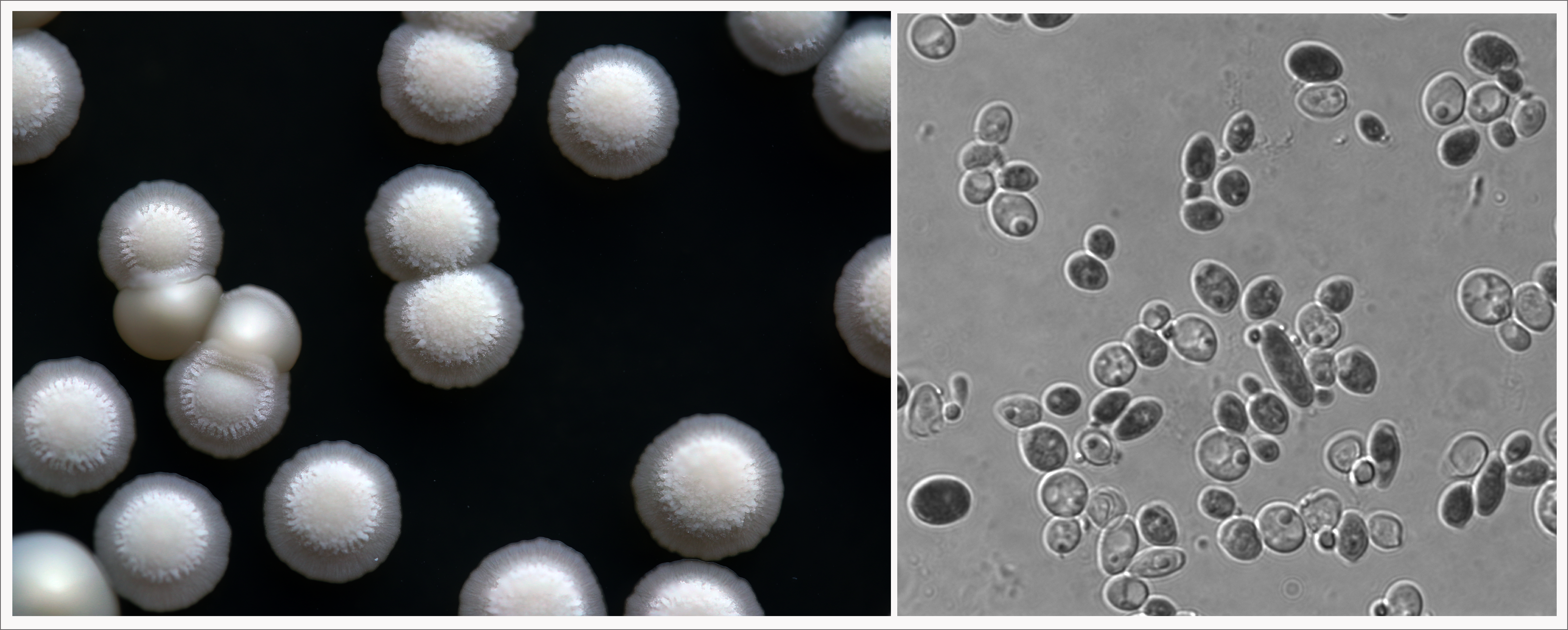
Left: W. anomalus are the highly textured white colonies. Right: W. anomalus cells at magnification.
Alternate names include: Pichia anomala
Other environments where it has been found:
The body of the sand fly Phlebotomus perniciosus, fermented chili sauce, olive brine, the body of the mosquito Anopheles stephensi, rose and cherry blossoms in Japan, surface water in South Africa, miso, camel milk in Algeria
What is it doing in my sourdough? W. anomalus is known to be a common yeast found across many environments including fermented foods (Huang, Chang, and Huang 2012), and is indeed a very common inhabitant of the sourdough starters we surveyed. This species is famous for its ability to produce something called yeast killer toxin, as well as a lot of the volatile chemical isoamyl acetate, which smells like artificial banana. Both of these products can inhibit other yeasts and molds (Coda et al. 2011; Cappelli et al. 2014). These competitive evolutionary strategies may be responsible for the abundance of W. anomalus across environments, including sourdoughs.
Naumovozyma castellii

Left: N. castellii are the smaller, smooth white colonies. The fuzzy colonies are Pichia fermentans. Right: N. castellii cells at magnification.
Alternate names include: Saccharomyces castellii, Naumovia castellii
Other environments where it’s been found: “.. [Two strains were isolated from a] soil sample in Finland. Later, other strains have been isolated from various substrates, such as fermenting cucumbers in the USA, butter milk and ensiled maize in the Netherlands, soil in South Africa, and the contents of caecum of baboon in Mozambique” (Karademir Andersson and Cohn 2017).
What is it doing in my sourdough? There is little research on what N. castellii is doing in sourdough. If you find any information or have observations to share, please add them to the comments at the end of this post.
Kazachstania humilis
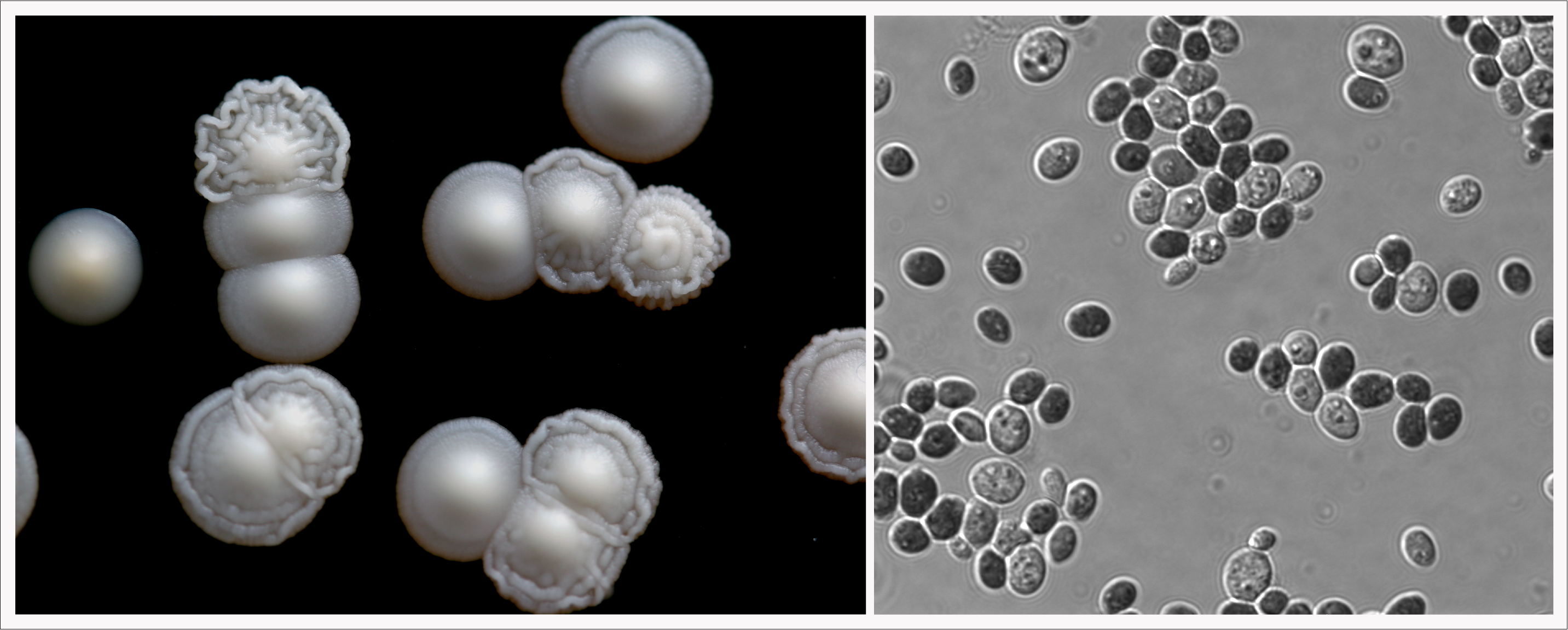
Left: K. humilis is the smallish, pale orange/white colony at the very left (the other colonies are Saccharomyces cerevisiae). Right: K. humilis cells at magnification.
Alternate names include: Candida humilis
Other environments where it’s been found: Mangrove sediments from East and West coasts of India, orange juice in China, soidon (bamboo shoot fermentation) in India, rotten oranges in Egypt, cocoa fermentation in Brazil, tequila in Mexico, beer in South Africa
What is it doing in my sourdough? After S. cerevisiae, K. humilis was the most common yeast identified from starters according to a survey of many sourdough studies from 1978 to 2016 (De Vuyst et al. 2016). Unlike S. cerevisiae, K. humilis cannot utilize the sugar maltose, so it is thought to form associations with microbes that can break down maltose, such as the bacterium Lactobacillus sanfranciscensis (Laureys and De Vuyst 2014; Gullo et al. 2003).
Kazachstania bulderi
Alternate names include: Saccharomyces bulderi
Other environments where it has been found: maize silage in the Netherlands, Kimchi
What is it doing in my sourdough? Little is known about K. bulderi, except that it has been isolated from many fermentations, and that it generally seems to prefer growing in anaerobic environments (Middelhoven, Kurtzman, and Vaughan-Martini 2000). It was also the first yeast known to anaerobically ferment gluconolactone, a breakdown product of glucose (Middelhoven, Kurtzman, and Vaughan-Martini 2000; van Dijken et al. 2002) which should be abundant in sourdough.
Kazachstania exigua
Alternate names include: Saccharomyces exiguus
Other environments where it’s been found: Kefir fermentation, soil in South Africa, coffee wastewater in Brazil, a natural CO2 spring in Slovenia, Japanese kimchi, beer in Japan, leaf-cutter ant Atta texana nest, taberna- a traditional palm wine from Southeast Mexico, Mangrove sediments from East and West coasts of India, rainbow trout intestines in Turkey, fish bodies from the East China Sea
What is it doing in my sourdough? K. exigua is one of the most common yeasts isolated from sourdough starters according to (Laureys and De Vuyst 2014). Like K. humilis, it is not able to utilize maltose, so it is thought to form associations with microbes that can break down maltose, such as the bacterium Lactobacillus sanfranciscensis.
Kazachstania barnettii
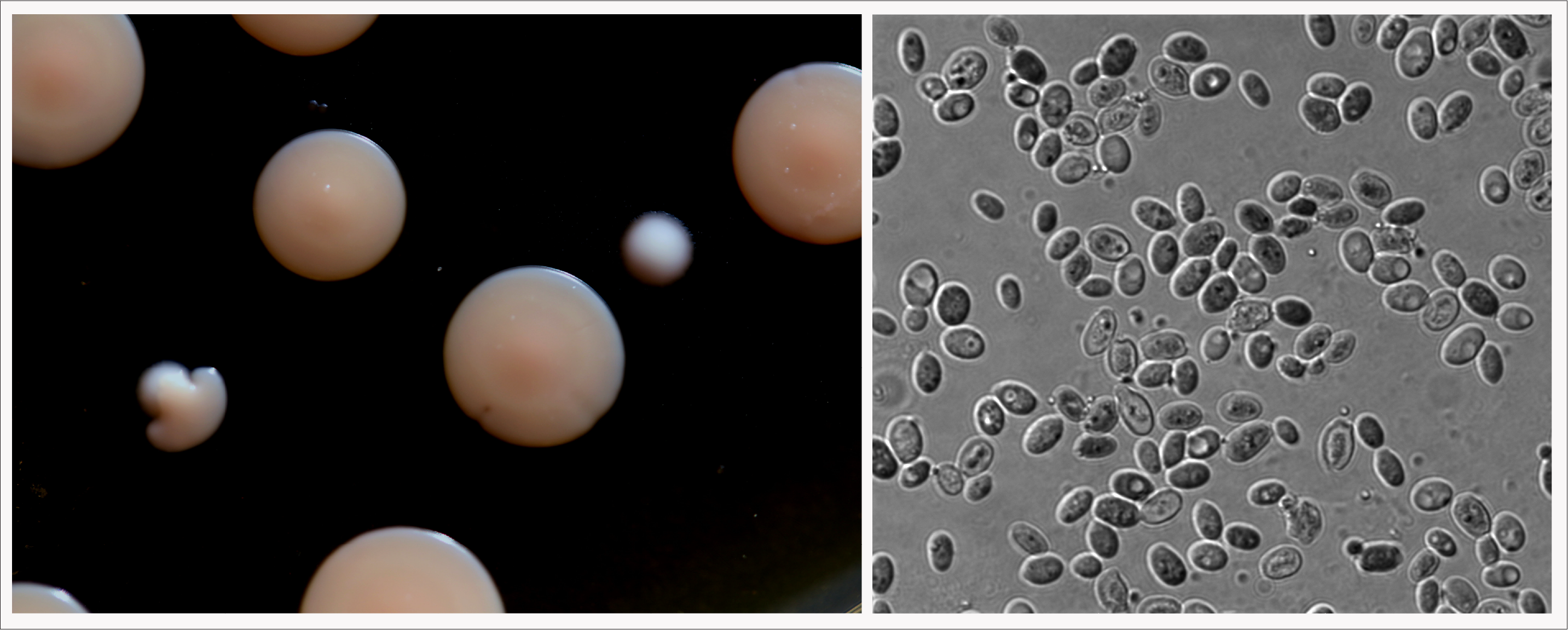
Left: K. barnettii growing as colonies. Both the large pink colonies and the small white colonies are K. barnettii Right: K. barnettii cells at magnification.
Other environments where it has been found: A soft drink in France
What is it doing in my sourdough? K. barnettii was first identified in sourdough in 2010 by Vrancken et al., and they determined it to be maltose-negative (meaning that it can’t utilize maltose as a carbon source), so it is thought to associate with bacteria that can. Vrancken et al. (2010) proposed that this yeast may associate with the maltose-positive Lactobacillus sanfranciscensis, like K. exigua.
Kazachstania naganishii
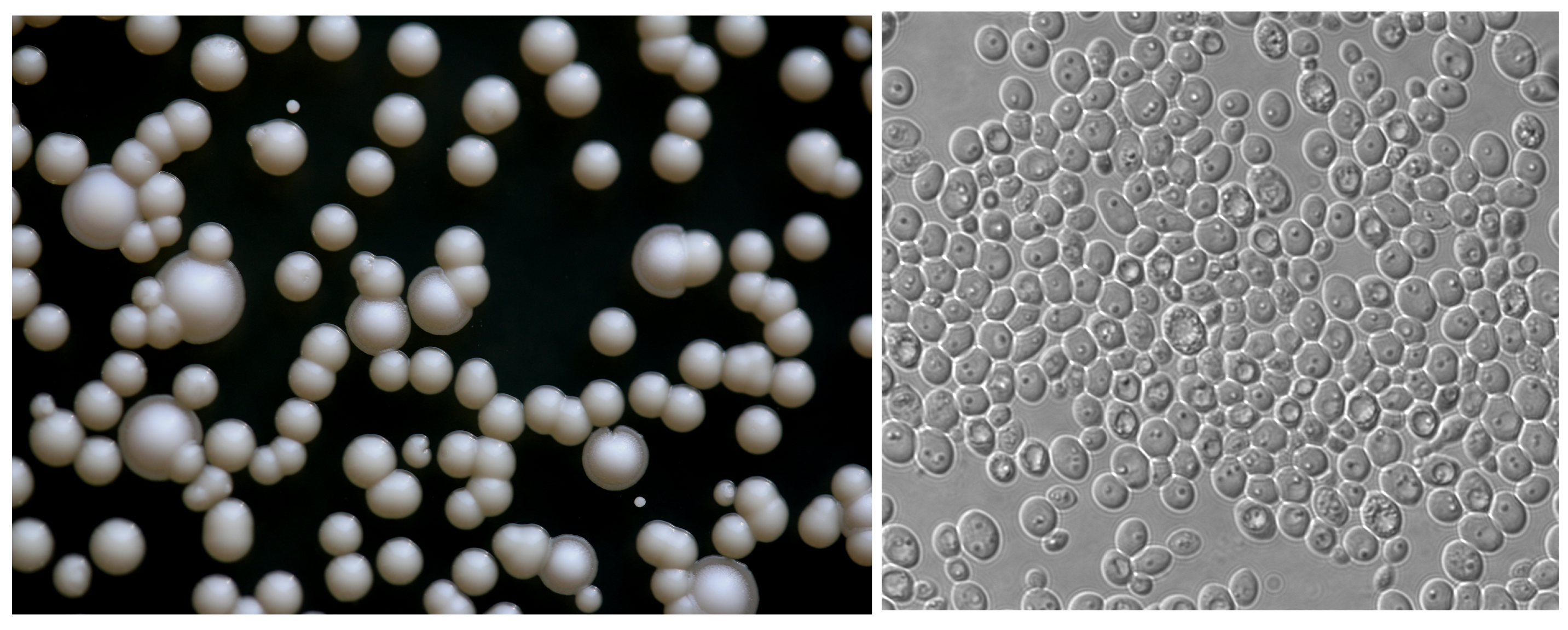
Left: K. naganishii growing as colonies. The smaller shiny colonies (without rings around them) are K. naganishii. Right: K. naganishii cells at magnification.
Alternate names include: Saccharomyces naganishii
Other environments where it has been found: Soil and plants in Japan
What is it doing in my sourdough? As far as we can tell, we are the first to find this species in sourdough. Very little is known about the biology of this yeast, so we don’t really know what it might be doing in sourdoughs. Stay tuned to learn more as we continue to study these yeasts.
Saccharomyces bayanus
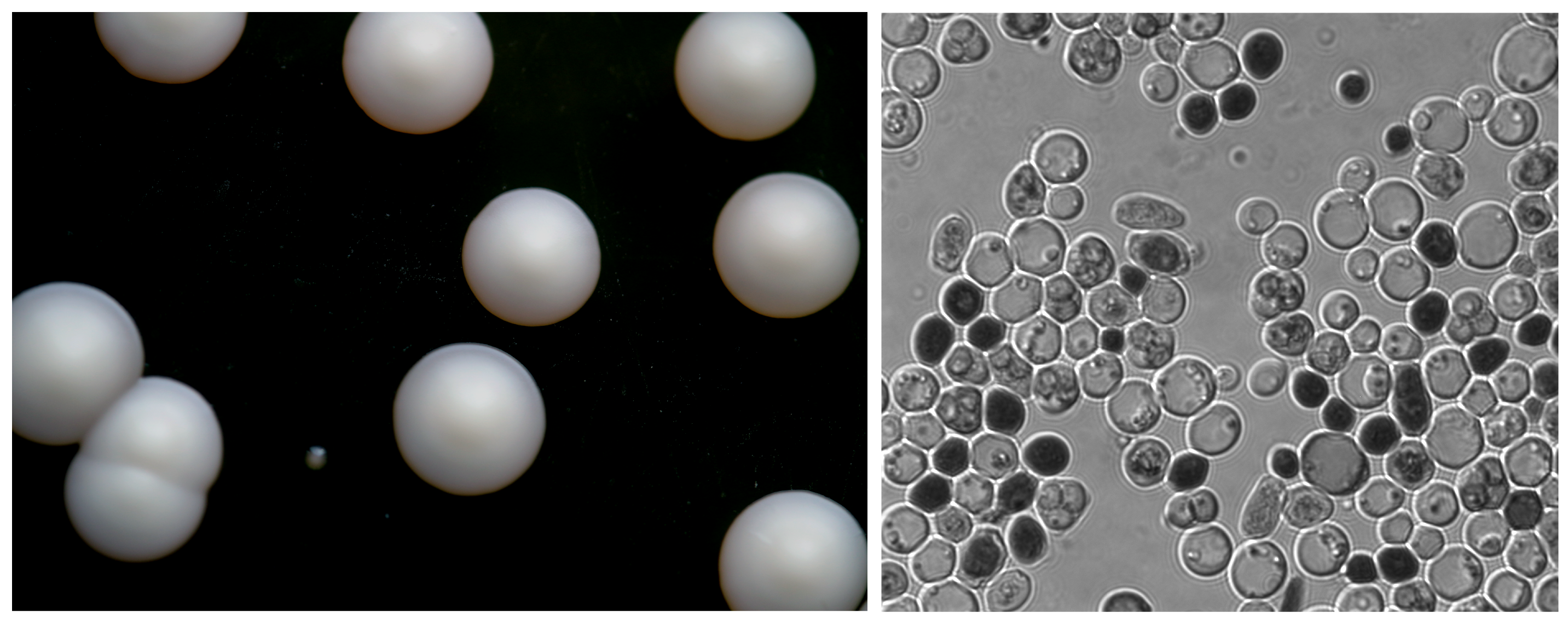
Left: S. bayanus growing as colonies. The tiny shiny colony is a bacterial species that snuck onto the yeast plate. Right: S. bayanus cells at magnification.
Alternate names include: Saccharomyces uvarum, Saccharomyces uvarum subspecies bayanus, and others.
Other environments where it has been found: Black currant juice in the Netherlands, wine and cider in France, apple chicha (a Chilean fermented beverage) in Patagonia, caddisflies in Spain, beer in the United Kingdom, “slimy material on a stump” in Hungary.
What is it doing in my sourdough? Saccharomyces bayanus is commonly found in sourdough (Di Cagno et al., 2014). It is also widely used in cider and wine-making. This yeast species is actually a hybrid of several other Saccharomyces species; because of this, the taxonomy and identification of S. bayanus gets tricky, and even controversial (Perez-Travez et al., 2014). Different strains of have been shown to have very different properties, so it’s difficult to say what S. bayanus is doing in sourdough.
**More useful notes on the information above.
About the names: Because of relatively recent advances in genome sequencing, many fungi including yeasts have undergone reclassification, so they have more than one name. This can be frustrating when trying to search for more information about particular yeast species on the internet. You can search this database to find synonyms for yeasts of interest. To further complicate things, some species also have multiple names because taxonomists used to name fungi differently if they were in their sexually or asexually reproductive stages. Wikipedia hosts a well-written explanation of why many yeasts and other fungi have multiple names.
About the photos: Colony photos (on the left) are “focus-stacked” images taken with a DSLR camera and a macro lens. Each macro photo is approximately 2 cm wide. The photos on the right are 100X magnification using DIC microscopy, and live cells were stained using methylene blue dye. Images are approximately 80 microns wide.
About the environments where these species have been found: For the most part, these locations and environments have been included because DNA has been extracted from an environmental sample (for example, from soil) and that DNA matches that of the yeast species in question. These lists are not meant to be comprehensive, but to give a sense of the breadth of environments that each species has been collected from. Caution should be taken when interpreting these lists. Yeasts are understudied in environmental samples; just because a yeast has not been identified in many samples does not mean it is rare.
Unless otherwise noted, these lists were curated by searching the National Center for Biotechnology Information database. Clicking on each “environment” will take you to that database and information about the sample from which it was collected.
Post written by Elizabeth Landis. All photos by Elizabeth Landis.
The production of this post was supported by Award # 1715553 from the U.S. National Science Foundation (more here).




How stable is the population in sourdough? Is there any intention of re-analyzing our sourdough at some stage?
Hi Glenda!
Excellent question! We think that the sourdough starters can be relatively stable. We may reach out to some participants to resample their starter.
Best,
Ben
Great info! I live in Australia and have just received the DNA results from my sourdough starter- Kazachstania bulderi!
It seems to me that there would be value in a common definition of a “stable” starter. Given that there are so many active species competing, each with slightly different environmental tolerance and nutritional characteristics, defining the “trajectory” of a growth cycle after feeding would be desirable if not essential if “stability” is to mean that the end state replicates the initial conditions. And the “trajectory” would include the effects of interdependence among the multiple populations in the mix.
Small changes in cultural practices may, over extended refresh cycles, dramatically alter the relative species populations in a starter. And we don’t (to my knowledge) have a good handle on the extent to which a specific culture is coupled to the flour it is being refreshed with. So there are a lot of loose variables likely impacting the spectrum of species even within a particular evolutionary track.
A (relatively simple) experiment would be to send seed samples to a few (as many as you can easily test when they come back) end users who would maintain the starter for some period of time, recording whatever you think might be of interest later, and returning a sample for testing. And for an even less complex experiment, the split/maintenance/re-testing could all be done in one lab.
[…] isn’t the one species dwelling in a sourdough starter. The fact is way more complicated. In research of starters from world wide, DNA sequencing from various samples has revealed the presence of a wide selection of untamed […]
[…] isn’t the only species living in a sourdough starter. The reality is much more complex. In studies of starters from around the world, DNA sequencing from varying samples has revealed the presence of a wide array of wild yeasts: […]
[…] isn’t the only species living in a sourdough starter. The reality is much more complex. In studies of starters from around the world, DNA sequencing from varying samples has revealed the presence of a wide array of wild yeasts: […]
[…] the only species living in a sourdough starter. The reality is much more complex. In studies of starters from around the world, DNA sequencing from varying samples has revealed the presence of a wide array of wild […]
[…] yeast is the common name for Saccharomyces exiguus, a naturally-occurring yeast that varies fascinatingly by region. The starter that you’re going […]